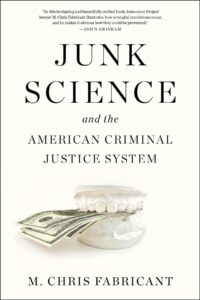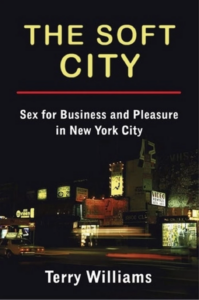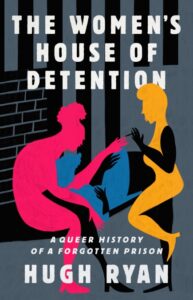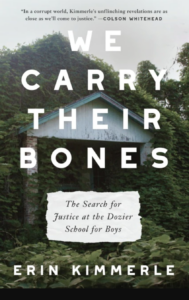2022 has been a banner year for true crime and critical nonfiction, and it was difficult to narrow it down to just the top 10 —and that’s just so far! August in particular has been a great month for new true crime, and you’ll see the month overrepresented in the following selections, but I promise that isn’t recency bias—it’s just a really great month for true crime. The selections on the list below run the gamut for the true crime genre, including an impassioned take-down of junk science, an erudite history of jazz and the underworld, a deeply empathetic examining of a sensational true crime case, a riveting account of a bizarre historical crime, ethnographic encounters with the NYC sex industry, a clear-eyed reckoning with Southern history, a queer history of a women’s prison, a timely investigation of a shocking historical courtroom drama, and a South American-set tale of intergenerational trauma. Keep an eye out towards the end of December for our Best True Crime of the year and Best Critical/Biographical Crime of the year.

M. Chris Fabricant, Junk Science and the American Criminal Justice System
(Akashic)
Much of the so-called “forensic pathology” developed and professionalized in the 20th century has now been discredited, and DNA has emerged in the 21st century as the only scientifically tested and proven method for forensics-based conviction. M. Chris Fabricant’s ground-breaking new work is here to explain (and explain well) what happened, where we went wrong, and how many have paid the price of junk science convictions. Fabricant’s long involved with the Innocence Project lends his book credence and weight, as he details overturned convictions, shoddy research, and the vast egos that underpinned some of the worst work in the history of criminal (in)justice. –Molly Odintz, CrimeReads senior editor

T. J. English, Dangerous Rhythms: Jazz and the Underworld
(William Morrow)
T.J. English’s newest slice of American noir culture is a sweeping history of the long, entangled tradition of jazz and organized crime, from the early days of Storyville, with Black performers and Sicilian club owners operating a complicated network of protection, endorsement, exploitation, and wild, creative invention. In cities across America, jazz musicians often found their homes in connected clubs and performing venues. Some believed it was to their benefit, but as the century rolled on, divisions within the arts community began to spread, as some musicians no longer wanted to play along for the mobsters who had a taste of their careers and profits. So in the end, the story becomes a distinctly American one, of course: of racial inequality, economic injustice, and the immortal art form that sprang from this hotbed of corruption and striving. –Dwyer Murphy, CrimeReads editor-in-chief

Kathleen Hale, Slenderman: Online Obsession, Mental Illness, and the Violent Crime of Two Midwestern Girls
(Grove Press)
Kathleen Hale initially wrote about the Slenderman case for Hazlitt, an article that still stands out from the general sensationalist coverage of the case for its enormous empathy for all involved. When two middle schoolers stabbed another middle schooler in the woods in 2012, they claimed to do it on behalf of a mysterious figure known as Slenderman. Hysterical parenting sites spread a moral panic about CreepyPasta, the website where stories of Slenderman originated and then became memes, but undiagnosed schizophrenia, midwestern stoicism, and intense friendship dynamics are much more to blame for the attack, as Kathleen Hale illustrates in both the original article and now a full-length title. –MO

Susan Jonusas, Hell’s Half-Acre: The Untold Story of the Benders, America’s First Serial Killer Family
(Viking)
The story of the “Blood Benders”—the homesteading family in 1870s Kansas believed to have perpetrated one of the most grisly slaughters of the 19th century—is well known, or at least we think we know it. That’s where Jonusas’ illuminating new study comes in. The family itself remains something of an enigma, as they escaped the mobs descending on them looking for justice, but Jonusas finds, in their escape, a bigger story that depicts the country at an auspicious moment, as the frontier was beginning to close and new industries and attitudes were pushing their way across the nation. Jonusas’ dogged archival work reveals new truths that cut through the legend—in particular, she traces the Benders’ fugitive journey and appears to have solved a great portion of the mystery surrounding their escape. She also brings to life the marshals and other detectives on their trail, as well as the families left behind to grieve the victims. In all, it’s a masterful portrait of a nation revealing itself through one of its most atrocious crimes. –DM

Terry Williams, The Soft City: Sex for Business and Pleasure in New York City
(Columbia University Press)
Before the Disneyfication of Times Square, before luxury high-rises took over the meatpacking district, before the sex trade vanished from the corners and went indoors to secret semi-public spaces, before porn migrated from the theater to the internet, New School ethnography professor Terry Williams and his students roamed the streets of New York City doing fieldwork and having encounters with the denizens of the so-called “Soft City”—a place defined by activities and encounters, not marked or mapped geography, “an invisible part of the city by day and a lively, excitingly risqué section by night.” In this idiosyncratic exploration of the city and its sexual underground, Terry Williams alternates between academic inquiry and the fieldwork of himself and his students for a fascinating and thought-provoking new work. –MO

Beverly Lowry, Deer Creek Drive: A Reckoning of Memory and Murder in the Mississippi Delta
(Knopf)
In Beverly Lowry’s hometown, when she was a small child just beginning to learn the horrific history of the American South, an elderly white woman known for being hateful was murdered with great violence. Her daughter tried to blame the crime on a Black man, but was instead put on trial herself—he attack was too brutal and lengthy for the townsfolk to ascribe such violence to the vulnerable Black community; what’s more, the daughter was suspected of a too-close relationship with a schoolteacher and this, combined with her mannish courtroom outfits, signaled her to be a gender rebel and thus a probable murderess. The daughter found herself convicted, but unending support from her loving husband (the contra-indicator for her suspected lesbianism) and the class differences between this upper-class wife and mother and her lower-class prisonmates eventually convinced the governor to secure her release back into the community that had so rejected her during the trial. –MO

Hugh Ryan, The Women’s House of Detention: A Queer History of a Forgotten Prison
(Bold Type Books)
For over a century, a prison stood at the heart of Greenwich Village; in the 20th century, now a women’s prison, the Women’s House of Detention incarcerated, educated and radicalized queer women from every walk of life and provided a space to challenge sexual binaries and gender norms, even as conditions inside the prison continuously deteriorated. Women and transmasc/gender-non-conforming people rioted in solidarity with the Stonewall Uprisings, which they could see from their windows. Queer denizens of the village waited in the dime store across the street from the prison to witness the comings and goings of their friends, allies, and neighbors. Wealthy bohemians went slumming at the women’s night court, desperate for the drama of human passions to interrupt their lives. And political prisoners were forced to examine their own prejudices towards queer women upon witnessing the many forms of family defining life behind bars. –MO

Sarah Weinman, Scoundrel: How a Convicted Murderer Persuaded the Women Who Loved Him, the Conservative Establishment, and the Courts to Set Him Free
(Ecco)
How could this have happened? That’s the question at the heart of Weinman’s latest incisive study of crime and culture. This time she’s looking at the long, strange, post-conviction life and crimes of Edgar Smith, who was on death row following a conviction for the murder of Victoria Zielinski, and from there managed to strike up a correspondence with William F. Buckley, of all people. The relationship grew to much more than a correspondence, as Smith ultimately convinced Buckley and others to become his champion. Soon enough, he had his freedom and the appearances and book deals came rolling in, until he attempted another murder, upending the lives of those who had supported him and countless others along the way. It’s one of the more bizarre sequences in modern American history, and brutally revealing of Buckley’s neoconservative narcissism and weakness to flattery. But he was just one along the way: Weinman’s book is a study in how person after person can be brought under a killer’s influence, and just how much damage a true psychopath can due with all that credulity. –DM

Javier Sinay, The Murders of Moisés Ville: The Rise and Fall of the Jerusalem of South America
Translated by Robert Croll
(Restless Books)
The Argentine investigative journalist Javier Sinay, in his new book, The Murders of Moisés Ville, brings his professional craft to bear on an intensely personal story: of the Jewish settlement of Argentina’s agricultural lands, and of the atrocities the new immigrants suffered there. For Sinay, the story begins with the discovery of a 1947 article written by his great-grandfather, addressing the murder of twenty-two settlers. The reader is then taken along for the investigation as Sinay discovers his great-grandfather’s central place in the era’s Yiddish-speaking community of Argentina. Sinay is soon learning Yiddish himself to better relay the stories of people who fled czarist Russia in search of a new life in the “Jerusalem of South America,” only to find new dangers and oppressors waiting for them. Starvation, land inequality, and bands of violent gauchos were just some of what the community faced, and their stories were passed down through family lore and through the country’s Yiddish press. Sinay’s new book is at once a compelling piece of journalism born of archival research and interviewing, and also a meditation on cultural legacies and inter-generational trauma. –DM

Erin Kimmerle, We Carry Their Bones: The Search for Justice at the Dozier School for Boys
(William Morrow)
This book is intense, moving, and highly necessary. Erin Kimmerle, a forensic archeologist, tells the story of the Dozier School for Boys (chronicled in telling prose by Colson Whitehead’s The Nickel Boys) and the survivors’ quest to inter and rebury with dignity the many victims of the school’s brutality. –MO
Notables:
Erika Krause, Tell Me Everything: The Story of a Private Investigation (Flatiron) · Martin Edwards, The Life of Crime: Detecting the History of Mysteries and their Creators (HarperCollins) · Jarrett Kobek, Motor Spirit: The Long Hunt for the Zodiac (We Heard You Like Books) · Patrick Strickland, The Marauders: Standing Up to Vigilantes in the American Borderlands (Melville House) · Rachel Rear, Catch The Sparrow: A Search for a Sister and the Truth of Her Murder (Bloomsbury) · Neal Bradbury, A Taste for Poison: Eleven Deadly Molecules and the Killers Who Used Them (St. Martin’s) · Paul Fischer, The Man Who Invented Motion Pictures: A True Story of Obsession, Murder, and the Movies (Simon & Schuster) · Patrick Radden Keefe, Rogues: True Stories of Grifters, Killers, Rebels and Crooks (Doubleday) · Fabián Escalante, 634 To Kill Fidel (Seven Stories Press) · John Wood Sweet, The Sewing Girl’s Tale: A Story of Crime and Consequences in Revolutionary America (Henry Holt) · Kathryn Miles, Trailed: One Woman’s Quest to Solve the Shenandoah Murders (Algonquin Books) · Chas Smith, Blessed are the Bank Robbers: The True Adventures of an Evangelical Outlaw (Abrams) · Carla Valentine, The Science of Murder: The Forensics of Agatha Christie (Sourcebooks) · Martin Sixsmith, The War of Nerves: Inside the Cold War Mind (Pegasus Books) · Jefferson Morley, Scorpions’ Dance: The President, the Spymaster, and Watergate (St. Martin’s) · Huw Lemmy and Ben Miller, Bad Gays: A Homosexual History (Verso) · Jim Cosgrove, Ripple: A Long Strange Search for a Killer (Steerforth Press) · John Gleeson, The Gotti Wars: Taking Down America’s Most Notorious Mobster (Scribner) · Eden Collinsworth, What the Ermine Saw: The Extraordinary Journey of Leonardo Da Vinci’s Most Mysterious Portrait (Doubleday) · James T. Bartlett, The Alaskan Blonde (Territory Books) · Nancy Dougherty, The Hangman and His Wife: The Life and Death of Reinhard Heydrich (Knopf) · Howard Blum, The Spy Who Knew Too Much: An Ex-CIA Officer’s Quest Through a Legacy of Betrayal (Harper) · Leslie McFarlane, Ghost of the Hardy Boys (David R. Godine) · Keith Thompson, Born to Be Hanged: The Epic Story of the Gentlemen Pirates Who Raided the South Seas, Rescued a Princess, and Stole a Fortune (Little Brown) · Benjamin Gilmer, The Other Dr. Gilmer: Two Men, a Murder, and an Unlikely Fight for Justice (Ballantine) · Brian Hochman, The Listeners: A History of Wiretapping in the United States (Harvard) · Mark Arsenault, The Impostor’s War: The Press, Propaganda, and the Newsman Who Battled for the Minds of America (Pegasus)

















